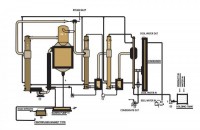TRIVENI ENGINEERING - AHMEDABAD
- Home
- Triveni Engineering
- Evaporators
Evaporators
Types and Design
In the evaporation process, concentration of a product Is accomplished by boiling out a solvent, generally water. The recovered end product should have an optimum solids content consistent with desired product quality and operating economics. It is a unit operation that is used extensively in processing foods, chemicals, pharmaceuticals, fruit juices, dairy products, paper and pulp, and both malt and grain beverages. Also it is a unit operation which, with the possible exception of distillation,is the most energy intensive.While the design criteria for evaporators are the same regardless of the industry involved, two questions always exist: is this equipment best suited for the duty, and is the equipment arranged for the most efficient and economical use? As a result, many types of evaporators and many variations in processing techniques have been developed to take into account different product characteristics and operating parameters.
Types of Evaporators
The more common types of evaporators include:
| Batch pan | Rising film tubular |
| Forced circulation | Plate equivalents of tubular evaporators |
| Natural circulation | Falling film tubular |
| Wiped film | Rising/ falling film tubular |
Applications
Although plate evaporators can be used on a broad range of products, the main application has been with products that are heat sensitive and therefore benefit from the high HTC's and low residence time. Products that are being processed in this evaporator include:
| Apple Juice | Coffee | Pear juice |
| Amino acids | Fruit purees | Pectin |
| Beef broths | Gelatin | Pharmaceutical products |
| Beet juice | Grape juice | Pineapple juice |
| Betacyclodextrin | Lime juice | Skim milk |
| Caragenan | Liquid egg | Sugars |
| Cheese whey | Low alcohol beer | Vegetable juices |
| Chicken broth | Mango juice | Whey protein |
| Citrus juice | Orange juice | Whole milk |
| Falling film tubular | Rising/falling film tubular | |
Multi-Effect Evaporation
Multi-effect evaporation uses the steam produced from evaporation in one effect to provide the heat to evaporate product in a second effect which Is maintained at a lower pressure . In a two effect evaporator, it is possible to evaporate approximately 2 kgs of steam from the product for each kg of steam supply. As the number of effects is increased, the steam economy increases. On some large duties it is economically feasible to utilize as many as seven effects. Increasing the number of effects,for any particular duty, does increase the capital costsignificantly and therefore each system must be carefully evaluated. In general, when the evaporation rate is above 3,000 lbs/h (1,350 kg/h), multi-effect evaporation should be considered.









